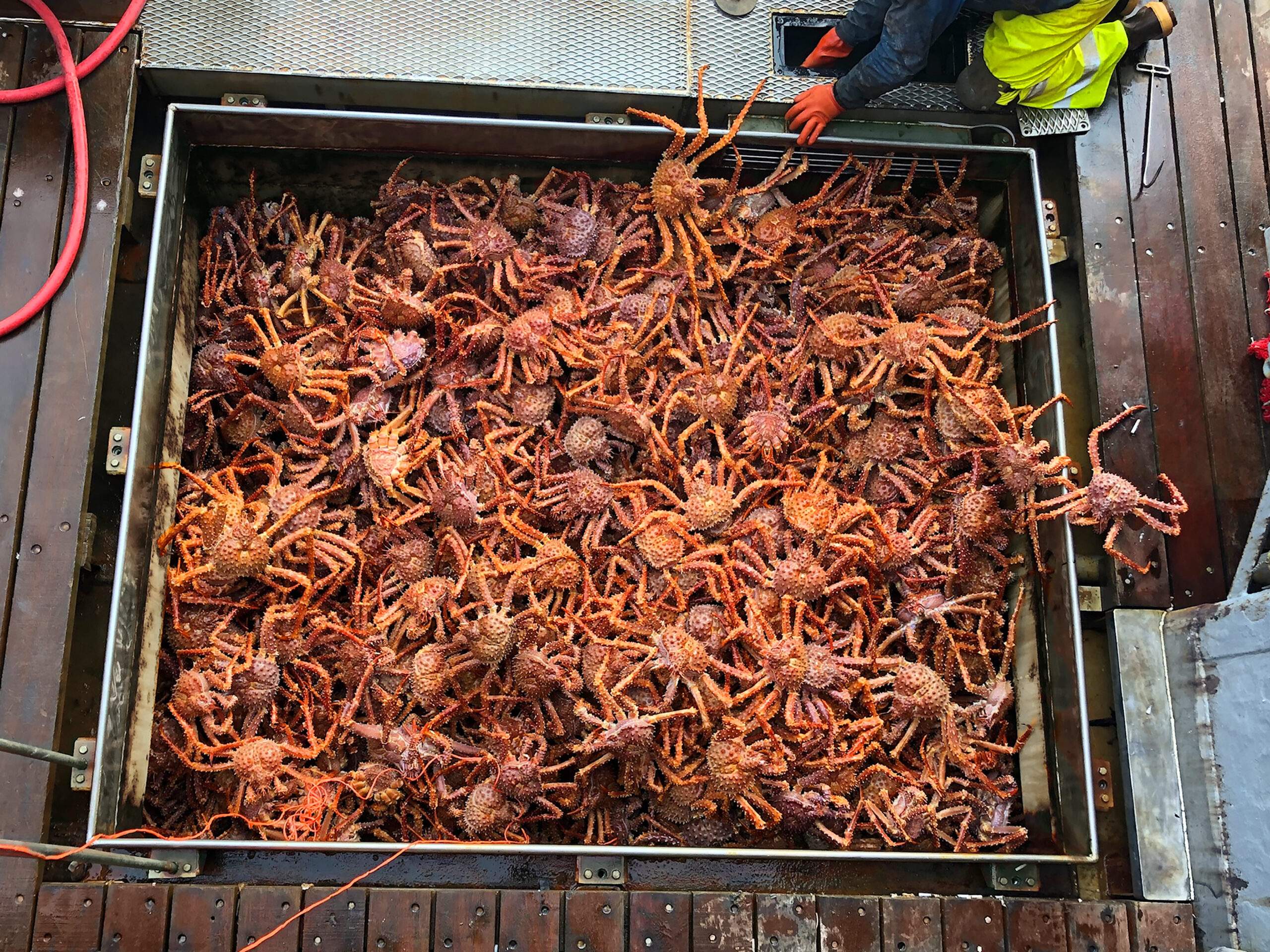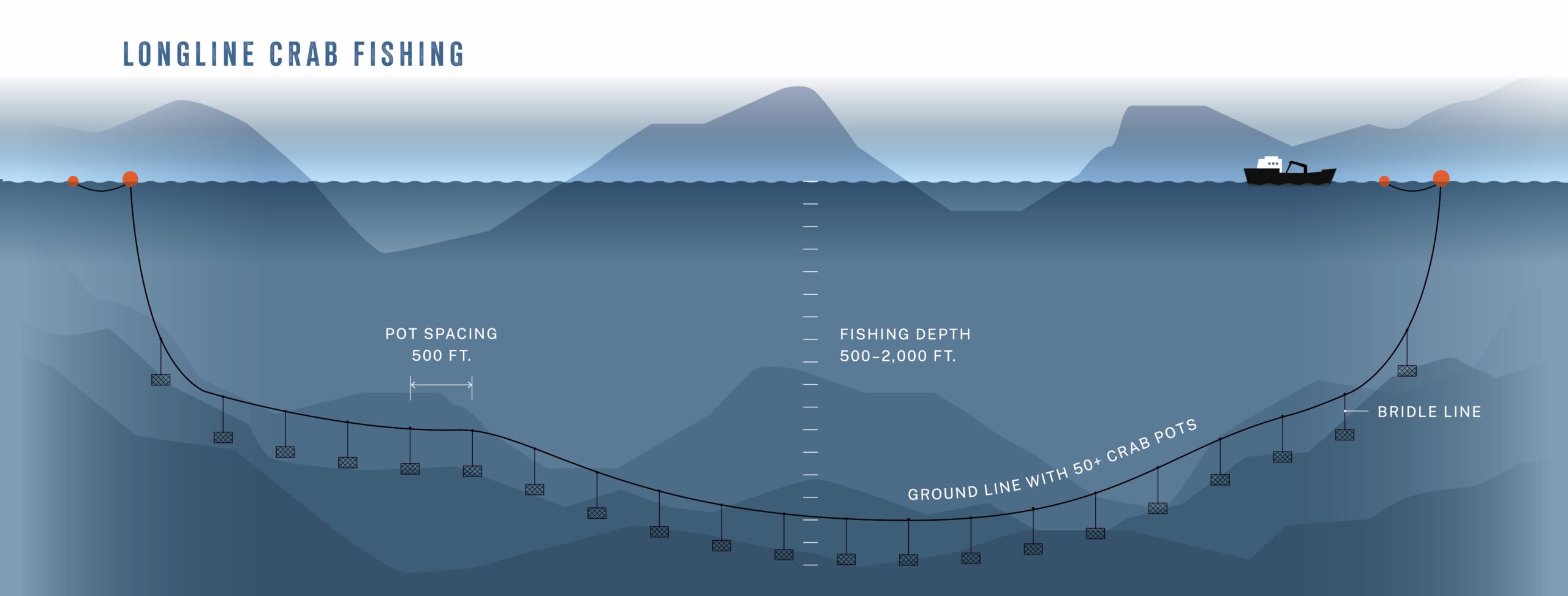
Why have Alaska Golden King crab populations remained thriving and steady while other crab fisheries in Alaska face declining numbers and reduction in fishing quotas? Our guest author, Kristian Poulsen, digs into the science to figure out what drives the resilience of the Golden King crab fishery.
Location, Location, Location: The Golden King Crab Habitat
Golden King crab live in rocky, high-relief habitats, deep in the Aleutian Trench. In contrast, Red King crab live in muddy flat areas at shallower depths. Given the great depths of Golden King habitats, many traditional fishing styles are rendered nearly impossible. We asked Ben Daly, a scientist for the Alaska Department of Fish & Game (ADFG), to give us a little more information about the differences between the Golden King and Red King crab habitats:
“Goldens prefer high relief habitats which means boulder or rocky habitats and live at depths around 1000 meters. Red King live in much shallower waters and generally don’t live in high relief habitat structure. Red King is much more accessible to fisheries than Golden King crab.”
The deeper habitat and rough seas of the Aleutian chain means that Golden King crab are hard to catch. In fact, only five vessels are equipped with the hydraulics needed to haul the long strings of pots from Alaska’s deepest commercial fishery.

Life Below the Thermocline
Given the deep habitat of Golden King crab, temperature plays a significant role in their sustainability. During their first years of life, crab are extremely susceptible to environmental changes. Goldens live below the thermocline, the transition layer between warmer mixed water at the ocean’s surface and cooler deep water below, and therefore experience fewer temperature fluctuations than species living closer to the surface. We asked Ben Daly to expand on why this protection from temperature fluctuations was so beneficial to Golden King crab population:
“They are deep enough that they are protected against warm temperature anomalies and environmental changes… There is very low abundance level of Bering Sea Snow crab and Red King. That is largely attributed to warming events in the Bering Sea. In the Aleutian Islands, we are not seeing that because the crab are more protected. The effects of climate change may eventually reach them, however, they have much more stable populations at this time. We feel very positive about the overall health of the population.”
Golden Partnership
The Golden King Crab Research Foundation is helping to connect fishermen to scientists to promote responsible harvesting and better relationships. We asked Scott Goodman, the head of the Golden King Research Foundation about their mission.
“The Golden King. Crab Research Foundation is a group of industry folks who have gotten together to form a research entity that is funded by the fishermen. We establish a working relationship with the science folks.”
Captain Rip of the FV Patricia Lee agrees that the close relationship between the fleet and the scientific community has been a key factor in the sustainability of the Golden King fishery:
“In the 35 years that I have been fishing Golden King crab, we have never seen a closure – not once. We have the best fishery management in the business and have spent years investing in the science through the Golden King Crab Research Foundation and our close partnership with ADFG. I have fished all over the world and I would say that Alaska Golden King crab is the most sustainable King crab fishery out there.”
Data-Driven Stock Assessment Process
While the Red King crab population is assessed through trawls, Golden King crab stock cannot be measured as easily. Because Golden King crab live in such high relief and rocky areas, scientists must be on the fishing boats to measure and track data with the help of the fleet. This collaboration between fishermen and scientists resulted in the Golden King Crab Foundation and has created a more open and healthier fishery.
Before the fishery opens, the ADF&G works with the Gold King Crab Research Foundation to identify survey areas. From there, the boats donate the first three weeks of the season to fish the declared survey areas while the onboard scientists keep track of the data.
As the season goes on, fishing begins as usual and the scientists continue collecting data on the catches, sometimes staying on the boat for up to 1/3rd of the season. While onboard, they consider information such as size, sex, number per pot, and many other variables. This data is then fed into state-of-the-art predictive models which allow us to catch a glimpse into the future of the fishery. While this specific form of data collection has only been taking place for about 5 years, scientists have been on the boats, side by side with fishermen, for over 30 years. This unique relationship has been key in keeping the Golden King Crab fishery particularly healthy.
Strong Investment and Commitment to Golden King Crab
Despite closures in the Red King and Snow crab fisheries this year, Golden King crab captains and vessel owners continued to invest in the future of Golden fishery through boat modifications, scientific partnerships, and even building an entirely new fishing vessels specifically designed for Golden King crab fishing. That commitment and significant investment shows the belief the industry has in the resilience and sustainability of the Golden King crab fishery even in the face of climate events.
About the Author:
Kristian Poulsen comes from a long line of Danish fishermen. He is currently in his final year of studying Business Administration at Seattle Pacific University.

